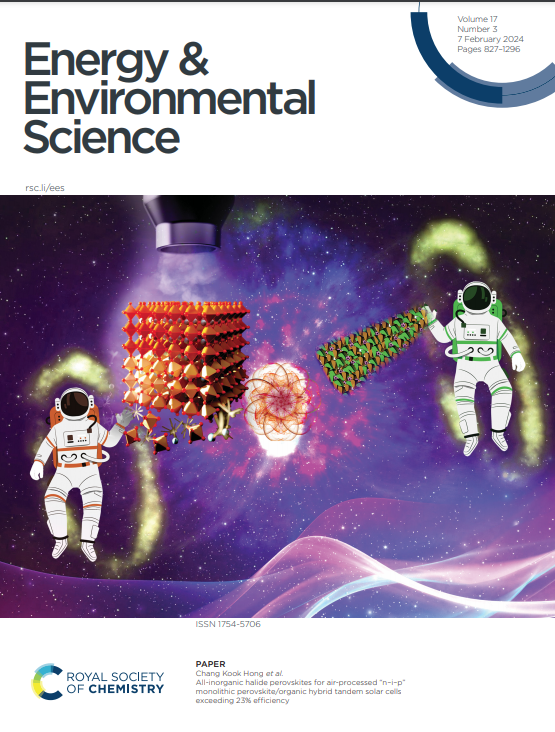d -葡萄糖醛酸酰胺添加剂的分子工程指导超稳定锌离子电池(100)取向锌沉积
IF 32.4
1区 材料科学
Q1 CHEMISTRY, MULTIDISCIPLINARY
引用次数: 0
摘要
水性锌离子电池(azib)内置的安全特性使其成为传统储能系统的可行替代方案。然而,它们的商业化受到树突生长和水介导的寄生反应等挑战的严重阻碍。本研究采用羟基、羰基和酰胺基团功能化的电解质添加剂d -葡萄糖醛酸酰胺(D-Glu)和三维结构,协同调节锌镀/剥离的热力学和动力学。实验结果和理论研究表明,氢键网络与D-Glu分子的高亲核性之间的协同相互作用,促进了水分子在Zn2+初级溶剂化壳内的优先位移,显著减少了电解质中的活性水,有效抑制了析氢反应(HER)。此外,官能团在不同晶面上的选择性吸附诱导Zn(100)晶面取向生长,形成无枝晶沉积,同时D-Glu分子通过位阻屏蔽锌表面缺陷,形成贫水界面微环境,抑制副反应。利用功能基团和位阻的优势,组装的锌对称电池在1ma cm - 2下具有超过4000 h的寿命,过电位低至25mv,在10ma cm - 2下具有9.6 Ah cm - 2的超高累积电镀容量(CPC)。此外,使用NH4V4O10 (NVO)阴极的电池在5 a g−1下循环2000次后仍保持了218 mAh g−1的可逆容量。因此,这项工作强调了分子设计在调节高性能下一代azib晶体取向方面的潜力。本文章由计算机程序翻译,如有差异,请以英文原文为准。

Molecular engineering of D-glucuronamide additive directs (100)-oriented Zn deposition for ultra-stable zinc-ion batteries
The built-in safety attributes of aqueous zinc-ion batteries (AZIBs) position them as a viable alternative to conventional energy storage systems. However, their commercialization is seriously hindered by challenges including dendritic growth and water-mediated parasitic reactions. Here, an electrolyte additive D-glucuronamide (D-Glu) functionalized with hydroxyl, carbonyl, and amide groups and a 3D architecture is introduced to co-modulate the thermodynamics and kinetics of zinc plating/stripping synergistically. Experiment results and theoretical studies reveal that synergistic interplay between the hydrogen-bonding networks and high nucleophilicity of the D-Glu molecule facilitates the preferential displacement of water molecules within the Zn2+ primary solvation shell, significantly reducing reactive water in the electrolyte and effectively suppressing the hydrogen evolution reaction (HER). Additionally, the selective adsorption of functional groups on different crystal planes induces orientational growth of Zn(100) crystal planes to form dendrite-free depositions, meanwhile, the D-Glu molecule shields zinc surface defects via steric hindrance, creating a water-poor interfacial microenvironment to inhibit side-reaction. Benefitting from the advantages of functional groups and steric hindrance, the assembled Zn symmetric cell achieves a prolonged lifespan of over 4000 h at 1 mA cm−2 with a low overpotential of 25 mV and an ultrahigh cumulative plating capacity (CPC) of 9.6 Ah cm−2 at 10 mA cm−2. Furthermore, the full cell with an NH4V4O10 (NVO) cathode retained a reversible capacity of 218 mAh g−1 at 5 A g−1 after 2000 cycles. Therefore, this work highlights the potential of molecular design in regulating the crystal orientation for high-performance next-generation AZIBs.
求助全文
通过发布文献求助,成功后即可免费获取论文全文。
去求助
来源期刊

Energy & Environmental Science
化学-工程:化工
CiteScore
50.50
自引率
2.20%
发文量
349
审稿时长
2.2 months
期刊介绍:
Energy & Environmental Science, a peer-reviewed scientific journal, publishes original research and review articles covering interdisciplinary topics in the (bio)chemical and (bio)physical sciences, as well as chemical engineering disciplines. Published monthly by the Royal Society of Chemistry (RSC), a not-for-profit publisher, Energy & Environmental Science is recognized as a leading journal. It boasts an impressive impact factor of 8.500 as of 2009, ranking 8th among 140 journals in the category "Chemistry, Multidisciplinary," second among 71 journals in "Energy & Fuels," second among 128 journals in "Engineering, Chemical," and first among 181 scientific journals in "Environmental Sciences."
Energy & Environmental Science publishes various types of articles, including Research Papers (original scientific work), Review Articles, Perspectives, and Minireviews (feature review-type articles of broad interest), Communications (original scientific work of an urgent nature), Opinions (personal, often speculative viewpoints or hypotheses on current topics), and Analysis Articles (in-depth examination of energy-related issues).
 求助内容:
求助内容: 应助结果提醒方式:
应助结果提醒方式:


